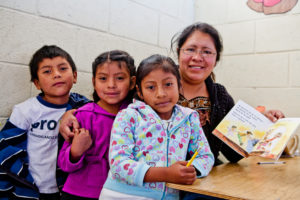Luis Miguel Can is a sixth-grade teacher in the remote village of Chocol, Guatemala. He grew up in a similarly isolated village in the country’s mountainous Central Highlands. Like the majority of indigenous children in Guatemala, he never had access to books.
As a child, Mr. Can struggled his way through a neglected educational system, and, working against the odds, made it all the way through high school. At 18, he became an elementary school teacher. When Mr. Can entered his first classroom as an instructor, he had no idea how to teach or promote reading. The idea of reading aloud to his students or engaging them in a book never even occurred to him. Of course, it hardly would have mattered anyway. He had no books.
“Teachers face so many obstacles here,” Mr. Can says. “The main one is lack of books and materials. The smidgen of money we get is for pens and maybe erasers. But never books.”
Another teacher in Chocol, a young woman named Olga Maribel Chávez, explains that it wasn’t just the lack of books that made learning to read so hard. “When I was little,” she said “no one placed any importance on reading. To this day, reading is hard for me. I still struggle.”

Mr. Can’s and Ms. Chávez’ challenges, both as children who grappled with reading, and now as teachers who struggle to teach it, are commonplace in Guatemala. Most teachers simply never bother to try to teach anything beyond simple phonetics. And without books, resources, training or support, it’s no wonder.
This year, Child Aid partnered with the school in Chocol and began its Reading for Life program in the village. We delivered dozens of storybooks to each of the school’s six classrooms and began our intensive teacher training program for Chocol’s teachers. Although the teachers are only four months into the program, they already report changes.
“I use Child Aid’s techniques all the time,” Mr. Can says. “It has been a wonderful experience, and the kids are really picking up reading. They’re getting it.”
Ms. Chávez, who is two years into the program because she taught in a neighboring community where Child Aid works, has had a similar experience. “The kids never used to want to read,” she says. “Now, even in this tiny school, the kids insist that I read to them. It never was like this.”
For Child Aid, literacy is a long-term commitment, one that goes beyond the creation of libraries and delivery of books. While these efforts are critical to our Reading for Life program, we believe that a truly effective, and sustainable, literacy program requires ongoing, practical training for teachers and librarians.
“If I had this program when I was a kid,” says Mr. Can, “I would have read every single day.”